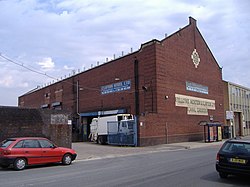Fellows Morton & Clayton Ltd was, for much of the early 20th century, the largest and best-known canal transportation company in England The company was in existence from 1889 to 1947.
Boats moored outside the Fellows Morton and Clayton basin in Nottingham
In the late 1850s a new boat-building facility was built at Tipton and by the early 1860s the fleet had grown to some 50 boats. Long-distance carrying was the mainstay of the business during these early years.
In 1876 Frederick Morton brought with him investment capital to expand the business, and the company name was changed to Fellows Morton & Co. This new company continued to absorb smaller traders, so expanding with new boats and also with acquired vessels.
Formation of the company
In 1888-1889 William Clayton of Saltley, who operated a special fleet of liquid cargo boats as well as traditional loads, became the third partner. William died before the companies merged formally but his son, Thomas, took his place. Fellows, Morton & Clayton Ltd. was formed on 3 July 1889.The three managing directors appointed at the first meeting of the new company were Joshua Fellows, Frederick Morton and Thomas Clayton, on salaries of £600 (equivalent to £60,000 in 2015), each. The new chairman of Fellows, Morton & Clayton Ltd was Alderman Reuben Farley the majority of shareholders being family members of the directors of the company.
At the time of formation the general cargo fleet amounted to some 11 steamers and around 112 butty boats. The tank boats were transferred to another new company which was called Thomas Clayton Limited of Oldbury.
The headquarters and basin at Fazeley Street, Birmingham
last known working boats in existence
currently there are only 29 of these boats still in existence 6 of which are still in use to this day the last remaining boats of this type are in the National waterways museum there are 12 recorded sink-ages and there are 2 currently in restoration the condition of the rest is currently unknown any information to improving this section is welcomeSteam-powered boats
1909-built FMC steam narrowboat President, preserved in working order, based at the Black Country Living Museum
In 1896 Fellows, Morton & Clayton Ltd tried iron in the construction of their boats. The boat had an elm bottom and iron sides. This proved much more effective and 3 of the 5 original steel steamers were rebuilt.
Between 1898 and 1899, 8 more iron composite steamers were produced from the Saltley dock and 9 more between 1905 and 1911.
The steamers were known as fly-boats or express-boats and kept mainly on main-line long-distance routes. On the timetable, a trip from London (City Road Basin) to Birmingham (Fazeley Street Depot) would take around 54 hours. It was a non-stop service and the crew of four would change shifts along the route. The main drawback was the lack of carrying space on the boat due to the size of the engine and boiler. The boats picked up coke at preset points along their routes.
President survives and is owned and operated by and from the Black Country Living Museum.
:o)
Source: From Wikipedia



Cool little boats. Beautiful scenery in the video. Liked the yellow iris too. I noticed the brick path running alongside the canals. Wonder if they used draft animals to pull the boats at one time. Reminded me of the C & O canal that ends in Washington D. C.
ReplyDeleteWe had the Morris Canal here in Joisey. Can still see parts of it!
DeleteInteresting, and NEAT!
ReplyDeleteWould be a fun way to spend the day!
DeleteYou find interesting stuff.
ReplyDeleteThank you, BW! Glad you liked it!
DeleteWonderful! Boats and steam, got me hooked. We used to have remnants of the old
ReplyDeleteErie Canal near where I grew up in NE Pennsylvania.
Yes, Terry the tow path was used by either mules or draft horses to pull the barges along the canal prior to steam power.
♬♬ "Fifteen miles on the Erie Canal" ♬♬
DeleteSteam Punk Boats!!! Gotta love it.
ReplyDeleteI have read about people living on this type of canal boat. Suppose it is a lifestyle similar to those here in the States who live full time in their RVs.
My Step-Grandfather owned a marina in the late 30's (one his many, many endeavors) and they all lived on a houseboat there. My Dad worked for him and that's how my parents met! :o)
Delete